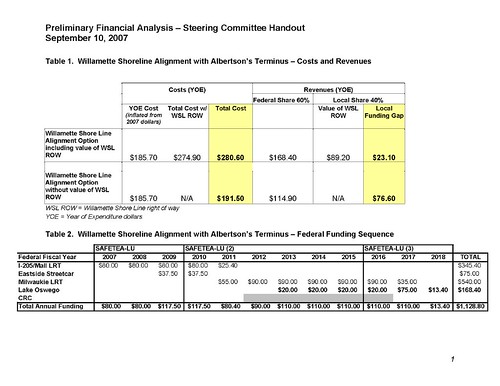This afternoon the Steering Committee composed of local electeds and representatives of two citizen advisory committees will meet to make a recommendation on a locally preferred alternative (LPA) for the Willamette Shoreline Transit project. The Steering Committee recommendation will set the framework for local governments around the region to adopt the LPA.
An LPA recommendation consists of a mode, route and terminus. In this case the recommendation is for those options to carry into an Environmental Impact Statement process, so multiple options can still be selected.
The documents for this meeting are now out:
- Agenda (PDF, 24K)
- Staff Overview Memorandum (PDF, 35K)
- LOPAC Recommendation (PDF, 18K)
- Project Management Group (staff) Recommendation (PDF, 79K)
- Financial Analysis (PDF, 32K)
- Project Schedule (PDF, 397K)
There will be two critical decisions: reconciling the differences between the LOPAC and staff recommendations, and figuring out how to advance the trail component of the project.
On the transit component, this table from the staff memo summarizes the differences in recommendations (note that LOPAC split closing 10-9 on whether to extend Streetcar south of Nevada St.). Besides deciding whether to screw up their courage to get through Dunthorpe, they’ll need to sort out other differences in the recommendation: whether to look at using the trolley right-of-way in Johns Landing and whether to continue study of the Safeway terminus in LO.
On the Trail side of the project, trail advocates will be looking for a commitment to keep the trail project moving forward. Here’s the language from the project management group recommendation on that point. It’s not clear yet if this language will satisfy the trail advocates:
a) Metro, with assistance from project partners through the TAC and PMG, should develop a process to undertake the Trail Refinement Next Steps listed above. The result of this process would be to resolve key issues and determine the relationship of the trail and the transit project during the DEIS phase. Of particular importance are:
i. Involvement of the public and advocacy groups in improving the trail concept
ii. Definition of the lead agency for advancement of a trail
iii. Development of an approach to reduce capital costs
iv. Analysis of possible phasing of trail segments
v. Identification of potential trail capital funding sources
Finally, the financial analysis reveals some interesting insights:
- In the best case we might build this with as little as $25M or so in local funding, due to the high value of the right-of-way.
- The staff assumptions about flows of Federal capital dollars to various rail projects in the region in next decade.

